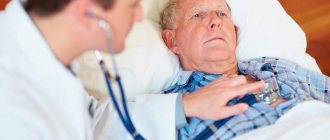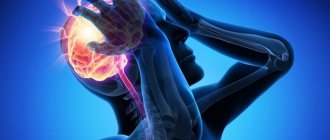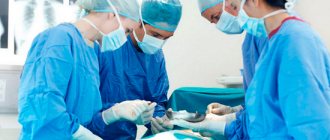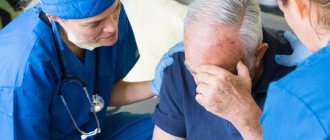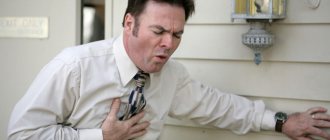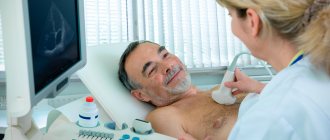Heartbeat
Palpitations - a feeling that the heart is beating too quickly or is beating too hard - is a reason to consult a doctor.
Heartbeat
is a patient complaint about the subjective sensation of a rapid, arrhythmic or heavy heartbeat. Normally, we do not notice our heartbeat. But any deviation from the norm becomes immediately noticeable. Patients typically describe palpitations as the following: the heart pounding too hard (or “loudly”) in the chest, the heart “jumping” out of the chest, pounding, “jerking,” “spinning,” or “fluttering.” Increased heartbeat may be accompanied by a feeling of pulsation in the neck, temples, pit of the stomach or fingertips. Palpitations may also be accompanied by tinnitus, pain in the heart area, a feeling of tightness in the chest or difficulty breathing. Such symptoms may indicate heart pathology, but in most cases, complaints of increased heartbeat with accompanying symptoms, instrumental studies do not reveal signs of heart damage.
Palpitations should be distinguished from tachycardia. Tachycardia
– this is an objective increase in heart rate. The normal heart rate for an adult at rest is 60-80 beats per minute. If more than 90 beats per minute are recorded, then tachycardia is diagnosed. However, the patient may not feel that his heartbeat is rapid.
Common causes of heart palpitations
Even a healthy person can feel increased heartbeat. This is most common for people with increased nervous sensitivity. The following can lead to heart palpitations:
- significant physical effort;
- rapid rise to altitude;
- physical activity in a hot and stuffy environment (lack of oxygen leads to increased heart function);
- sharp mental stress (fear, excitement, etc.);
- consuming large amounts of foods high in caffeine (coffee, tea, Coca-Cola);
- certain medications (in particular, cold remedies);
- digestive disorders (for example, flatulence, as a result of which the diaphragm appears slightly elevated).
Palpitations may be felt when the temperature is high (patients with a fever often feel palpitations).
Harm of alcohol to the cardiovascular system
Ethanol is a poison that affects almost all organs of a person who drinks alcohol. The heart is one of the first to suffer. Long-term alcohol abuse entails specific changes in the heart muscle. This phenomenon is called alcoholic cardiomyopathy.
When drinking alcohol, the following happens:
- blood pressure increases;
- pulse increases by about 25%;
- the load on the myocardium increases.
Blood transports oxygen and nutrients to tissues and organs more slowly. Tachycardia is typical even for healthy people. As a result, this leads to malfunctions of the myocardium. If the norm is followed, there will be no particular harm. However, if you exceed the recommended doses of alcohol, the load on the heart increases. This is especially true when combining the use of ethanol-containing drinks with smoking.
Increased heart rate and high blood pressure
Increased heart rate is often accompanied by increased blood pressure. In this case, the more often the heart contracts, the higher the pressure in the arteries. The dependence here is exactly that... Therefore, it is wrong to consider high blood pressure as the cause of increased heart rate. Another thing is that increased blood pressure, accompanied by a general deterioration in well-being, can make you notice how hard your heart is beating.
Rapid heartbeat and increased blood pressure can be caused by the same reasons. In this case, therapeutic measures aimed at normalizing blood pressure will also help normalize the heartbeat.
Increased heart rate and low blood pressure
An increased heart rate is quite possible even with low blood pressure. A sharp decrease in blood pressure can be observed during shock conditions (anaphylactic, traumatic, infectious-toxic, psychogenic and other types of shock). The body responds by speeding up the contraction of the heart muscle to restore blood pressure. A similar compensatory nature of increased heartbeat also occurs with large blood loss.
Rapid heartbeat with normal blood pressure
However, increased heartbeat can be felt regardless of blood pressure. The pressure may be low or normal, but the patient complains of palpitations. This is possible with vegetative-vascular dystonia, anemia, thyroid diseases and a number of other diseases. You should not try to determine what you are sick with, much less begin treatment only on the basis of comparing your heartbeat and blood pressure. In all cases when you are concerned about increased heart rate, you must undergo an examination as prescribed by your doctor.
Additional nutrition tips
If you experience regular changes in blood pressure after eating, you should follow a few simple rules that are also relevant for healthy people.
- Avoid overeating. You can eliminate the absorption of excessive amounts of food by eating small and often. The optimal solution is 5 meals a day in portions not exceeding 300 ml in volume.
- You shouldn't eat before bed. The last meal should be no later than 1-3 hours. Sleeping on a full stomach will be restless, and the body will need more energy to digest food, which can cause an increase in blood pressure.
- Fasting for hypertension or hypotension is excluded without consultation with the attending physician.
- The best way to prepare food is steaming, the worst way for vascular health is frying.
- It is important to maintain a drinking regime, drinking 1.5–2 liters of clean water per day. For chronic hypertensive patients, these numbers should be reduced, since a large amount of fluid can raise blood pressure.
- You should exclude carbonated drinks, fast food, unhealthy sweets, and canned food from your diet.
- The proportion of fiber-rich foods should increase.
- The main components of the plate should be vegetables, herbs, fruits, dairy products, lean meats and fish.
- If you feel that your blood pressure is rising after eating something, or your heart rate is increasing, you should measure your blood pressure and take the medications recommended by your doctor to stabilize your condition.
Advice! Coffee, tea, and alcoholic drinks should be replaced with water, juices, fruit drinks and compotes based on vitamin-rich fruits and berries.
No ads 2
When is palpitations a reason to see a doctor?
A rapid heartbeat is a reason to see a doctor if it:
- too intense;
- is protracted (does not go away for a long time);
- occurs with less and less exposure to the above factors;
- occurs independently of the above factors;
- is uneven in nature (arrhythmia can be assumed - a violation of the heart rhythm).
In these cases, rapid heartbeat may be a manifestation of serious disorders and diseases, such as:
- avitaminosis;
- anemia (low hemoglobin and iron in the blood);
- tetany (a condition caused by a lack of calcium);
- endocrine diseases;
- heart pathologies.
However, as a rule, in the case of myocarditis, other heart diseases, and hyperthyroidism, palpitations are not the main complaint. With such diseases, first of all, they complain of pain in the heart and shortness of breath.
It is necessary to react promptly if, against the background of increased heartbeat, dizziness, shortness of breath, pale skin, and sweating are observed. In this case, you should call an ambulance.
Tachycardia - symptoms and treatment
What to do during an attack
If a person is alone during a sudden attack of tachycardia, it is necessary to breathe deeply and also perform a Valsalva maneuver. To do this, close the glottis and strain the chest muscles for 10-15 seconds (can be compared to trying to push). For younger children, you can try exhaling from a syringe or drinking straw. For the same reaction in infants, you can apply ice packs to the face for a few seconds.
What actions should not be taken?
Without a thorough diagnosis and recommendations of the attending physician, you should not take any medications or dietary supplements. For some arrhythmic tachycardias, which are detected by electrocardiogram data, their use can be dangerous.
Elimination of the underlying disease
Treatment of prolonged tachycardia begins with eliminating the underlying disease of which it is a symptom, or some other causative factors. If the disease is known, then after appropriate treatment the tachycardia also stops.
For pheochromocytoma (adrenal tumor), which produces adrenaline, and sometimes for hyperthyroidism, treatment is surgery, after which one of the symptoms in the form of tachycardia disappears.
For thyroid diseases, treatment is either surgery or drug therapy.
For arterial hypertension, many drugs prescribed for its treatment not only reduce blood pressure, but also affect the heart rate, reducing it. If the use of such drugs is contraindicated, then cardiologists use a drug that acts only on the cells of the sinus node and exclusively slows down the pulse - ivabradine. The drug has a limited number of indications and is prohibited for independent use without consulting a specialist.
In case of anemia, restoration of hemoglobin levels and normalization of heart rate is facilitated by the administration of iron supplements (for iron deficiency anemia), vitamin B12 or folic acid (for B12-deficiency and folate-deficiency anemia), transfusion of blood components (for posthemorrhagic or aplastic anemia), as well as treatment of atrophic gastritis or parasitosis (diphyllobothriasis).
If tachycardia occurs in a healthy person and is associated with low physical development, then the solution is gradual endurance training. It includes increasing the activity of your lifestyle, increasing the complexity of physical training, performing static and dynamic exercises, walking at a moderate and fast pace, running at various distances with increasing difficulty, and swimming.
Treatment of supraventricular tachycardias
In the case of diagnosed supraventricular tachycardia (eg, atrial tachycardia, AVNRT, or atrial flutter), the first step is to assess blood pressure instability by the presence of the following signs:
- hypotension (low blood pressure);
- hypoxia (lack of oxygen in the body);
- dyspnea;
- chest pain;
- shock;
- signs of impaired perfusion (blood passing through the lungs).[2]
Electropulse therapy
If the patient is unstable, then immediate cardioversion is necessary - stimulating the heart with an electrical discharge. In this case, it is important that the defibrillator is in synchronization mode with the QRS complex (the main impulses on the ECG line). This mode allows the defibrillator to prevent shock transmission while the heart is depolarized (otherwise cardioversion could lead to polymorphic ventricular tachycardia).
Initial energy for synchronized cardiac pacing:
- in adults - 100-200 J, can be increased stepwise if there is no success;
- in children - 0.5-1 J/kg, can be increased to 2 J/kg with subsequent attempts.[5]
A patient with stable blood pressure should be prepared for chemical cardioversion - restoration of heart rhythm using drugs. To do this, it is recommended to stimulate the vagus nerve using the Valsalva maneuver and massage of the carotid artery. These methods stimulate the parasympathetic system, slow down the formation of an impulse in the sinus node and more.
For long-term treatment of recurrent supraventricular tachycardia, patients should be counseled on how to self-increase vagal tone.
Valsalva maneuver technique : closing the glottis and tensing the chest muscles for 10-15 seconds (can be compared to trying to push). For younger children, you can try exhaling from a syringe or drinking straw. For the same reaction in infants, you can apply ice packs to the face for a few seconds.
Applying pressure to the eyeballs can also stimulate the parasympathetic system, but this method is not recommended because excessive pressure can cause eye damage.[4][8]
Carotid artery massage technique : the patient lies on his back, neck extended, while using his fingers he presses on one carotid sinus for about 10 seconds. This massage is contraindicated in people with a single artery, patients who have suffered a transient ischemic attack or acute cerebrovascular accident within the last three months, or children or infants.[5]
Drug therapy
If the effect on the vagus nerve has no effect, then adenosine can be used to normalize the heartbeat. It must be administered intravenously. The initial dose is 6 mg (child dose - 0.1 mg/kg). If this dose is ineffective, then 12 mg can be administered (for children - 0.2 mg/kg). A second dose of adenosine (12 mg) may be given one more time if the desired effect is not achieved. Each dose of adenosine should be quickly rinsed with 10–20 ml of saline solution. If the patient is receiving carbamazepine or dipyridamole at the time of treatment, it is recommended to reduce the dose of adenosine to 3 mg.[1][11]
If the rhythm is misinterpreted, administering adenosine may help slow the heart rate for a long time. This will determine whether the tachycardia is caused by another subspecialty complex tachycardia (eg, atrial fibrillation or atrial flutter).
If adenosine is ineffective, you can use:
- diltiazem (0.25 mg/kg intravenously followed by 5-15 mg/hour infusion);
- esmolol (0.5 mg/kg intravenously, then 0.2-0.5 mg/kg per minute - must be repeated with each increase in titer);
- metoprolol (2.5-5 mg intravenously every 2-5 minutes, but not more than 15 mg over 10-15 minutes).
If the above drugs continue to be ineffective, pacing the heart at a rate faster than its own rate may eliminate supraventricular tachycardia. However, there is a risk of ventricular tachycardia or fibrillation and should be used with caution and with immediate availability of cardioversion.[4]
Patients with recurrent supraventricular tachycardia without preexcitation syndrome may require long-term treatment with oral beta-blockers or calcium channel blockers to maintain sinus rhythm. You may also need radiofrequency (catheter) ablation, a surgical treatment for arrhythmia using radiofrequency energy.
Treatment of AV nodal reentrant tachycardia
The primary treatment strategy for AVNRT also involves stimulation of the vagus nerve and administration of adenosine, which stops approximately 80% of arrhythmias. Second-line drugs include non-dihydropyridine calcium channel blockers, beta blockers, or digoxin.[8]
Surgery
If treatment with the above methods is unsuccessful, or medication is not possible due to side effects, then patients may choose catheter ablation as a one-time definitive treatment. This AVNRT treatment method is highly effective (successful in 95% of cases).
Chronic drug therapy using class III or IC antiarrhythmic agents (flecainide, propafenone, amiodarone, dofetilide or sotalol) may be used in cases where the body does not respond to calcium channel blockers or beta blockers, or if the patient refuses catheter ablation . The choice of these antiarrhythmics is usually related to comorbidities and side effect profile.[6][10]
Treatment of tachycardia with folk remedies
The use of traditional medicine often results in the patient not receiving timely, qualified treatment. With tachycardia, this can cause life-threatening complications such as stroke and myocardial infarction.
How can a doctor help with a strong heartbeat?
If you have a complaint about palpitations, you should contact a general practitioner or cardiologist.
When a patient complains of increased heartbeat, it is first necessary to establish its cause - whether it is of physiological or pathological origin. For this purpose, laboratory and instrumental studies may be prescribed, including ECG, echocardiography (ultrasound of the heart), and radiography of the heart. After identifying the cause of the increased heart rate, a course of treatment is prescribed aimed at eliminating pathological factors. Normalization of the heartbeat is achieved through treatment with antiarrhythmic drugs. Such drugs should not be taken on your own; they should be prescribed by a doctor in accordance with the condition of your body, established on the basis of a medical examination. Otherwise, the treatment result may be negative.
Publications on the topic of the month “How to overcome post-Covid syndrome”
- Lung recovery after coronavirus
- Restoring the sense of smell after coronavirus
- Overcoming mental disorders during post-Covid syndrome
- We are experiencing COVID. How the coronavirus pandemic affects mental functioning
- Post-Covid screening - examination after a new coronavirus infection
- How to return digestion to normal after coronavirus?
- Loss of smell due to COVID-19 - advice from an otolaryngologist
- Coronavirus turned out to be “vindictive” - what is important to know
- Melatonin and COVID-19 - a cure for Trump
- Post-Covid syndrome: program for diagnosis and regression of post-Covid symptoms. How to Manage Long-Term Long COVID Symptoms
